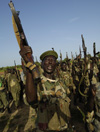
It’s a truism that in southern Sudan, history is living; it is essential to know the history of southern Sudan and its peoples to make sense of the equally historic machinations and crucial developments underway today.
Exhibit A is the current situation in Abyei, on the disputed border between North and South; many a southerner will tell you, “if there’s a return to [North-South] war, it’ll start in Abyei.” That assertion is, of course, well-grounded in recent and past history. The May 2008 bombardment of Abyei town by Sudanese Armed Forces that were a part of the Comprehensive Peace Agreement-mandated “Joint Integrated Units,” was arguably the greatest threat to the breakdown of the tentative peace brokered by the CPA since the agreement was signed in 2005.
Tensions are on the rise again in Abyei, reminiscent of a year ago, when anxious Abyei residents awaited the ruling of the Hague-based Permanent Court of Arbitration on the contested boundaries of the region. Although many observers (myself included) feared the worst in Abyei following the high-stakes court ruling, the aftermath was, at first glance, a best-case scenario. The NCP and SPLM pledged to immediately begin implementing the agreement by demarcating the new boundaries and sensitizing local populations—both the nomadic Misseriya populations who graze seasonally in the Abyei area and the native Ngok Dinka people—about the ruling.
Unfortunately, the parties have not kept their promises; the boundaries of Abyei remain un-demarcated (with the SPLM credibly alleging foul play by Khartoum through the use of unauthorized security forces to prevent demarcation in the area), and Abyei residents remain in the dark about their future. What is known for certain is this: on January 9, 2011, when the people of southern Sudan vote in their self-determination referendum, the people of Abyei are set to vote in a separate referendum, which should (according to the CPA and to the Abyei Referendum Act passed last December) enable them to choose to retain their “special administrative status” in northern Sudan or to join the South’s Warrap state.
In recent days, local tensions have flared in Abyei over the lack of progress on preparations for the Abyei referendum. On Monday, an estimated 3,000 Abyei residents marched to the gates of the U.N. Mission’s compound in Abyei to present a communiqué addressed to President Bashir that detailed their grievances, including discontent that the Abyei Referendum Commission had not yet been formed (the southern referendum commission was approved by the National Assembly more than two weeks ago and even that was delayed), the border demarcation had not progressed, and that SAF forces and “allied militias” have not withdrawn from the new boundaries of Abyei.
Then on Tuesday, reports emerged of a clash between gunmen and police in the village of Tajalei, roughly 20 miles northeast of Abyei town. Four civilians and a policeman were killed in this clash, which the Abyei chief administrator Deng Arop Kuol described to Reuters as a politically-motivated attack by Misseriya militia: “They are trying to disrupt the referendum activities, particularly the voter registration." This is not the first time southern officials have linked instability in Abyei to the nomadic Misseriya populations, who the SPLM often view as proxies for the NCP.
It is hard to predict what’s ahead for Abyei, but if history is any indication, this region will continue to be a volatile flashpoint, with local populations bearing the brunt of higher-level disputes between Khartoum and Juba.
Photo: SPLA soldiers in Abyei in 2008 (IRIN)

